![A transport of Jewish prisoners marches through the snow from the Bauschovitz train station to Theresienstadt. [LCID: 69720]](https://encyclopedia.ushmm.org/images/large/781755a6-1ba5-4d8e-8b2b-9f25bdf3687f.jpg)
Browse an alphabetical list of photographs. These historical images portray people, places, and events before, during, and after World War II and the Holocaust.
<< Previous | Displaying results 1-25 of 57 for "Photo" | Next >>
Nazi propaganda often portrayed Jews as engaged in a conspiracy to provoke war. Here, a stereotyped Jew conspires behind the scenes to control the Allied powers, represented by the British, American, and Soviet flags. The caption reads, "Behind the enemy powers: the Jew." Circa 1942.

The beginning of a ceremony to dedicate a new SS hospital in Auschwitz-Birkenau. A Nazi soldier salutes as the Nazi and SS flags are raised while a line of troops stand with rifles at attention during the dedication.From Karl Höcker's photograph album, which includes both documentation of official visits and ceremonies at Auschwitz as well as more personal photographs depicting the many social activities that he and other members of the Auschwitz camp staff enjoyed. These rare images show Nazis…
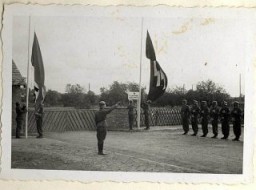
Belgian politician Léon Degrelle (center) stands in formation with fighters from the Belgian Volunteers who are on their way to fight in the Soviet Union. Belgium, August 15, 1941. During World War II, Degrelle founded a collaborationist military force that fought on the eastern front.
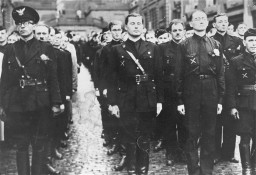
Victor Brack, one of the Nazi doctors on trial for having conducted medical experiments on concentration camp prisoners. Nuremberg, Germany, August 1947.
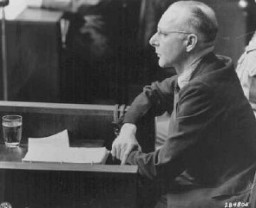
Nazi propaganda cartoon by Seppla (Josef Plank), a political cartoonist. Germany, date uncertain [probably during World War II].Beginning in the 1920s, Nazi propagandists promoted the antisemitic myth that Jews were engaged in a massive conspiracy to take over the world. This false notion alleged that “international Jewry” used various people and groups as part of a plan for global conquest. At the time, an octopus extending its tentacles over the globe was a common visual metaphor for this…
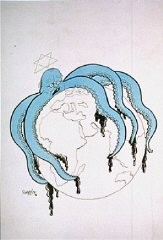
Nazi eugenics poster entitled "Feeble-mindedness in related families in four neighboring towns." This poster shows how "feeble-mindedness" and alcoholism are passed down from one couple to their four children and their families. The poster was part of a series entitled, "Erblehre und Rassenkunde" (Theory of Inheritance and Racial Hygiene), published by the Verlag für nationale Literatur (Publisher for National Literature), Stuttgart, Germany, ca. 1935.
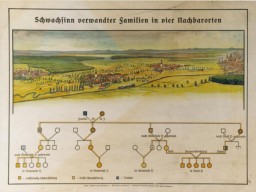
Psychiatric patients are evacuated to clinics where they will be murdered as part of the Nazi Euthanasia Program. Photo taken in Germany and dated circa 1942–1944.The term "euthanasia" usually refers to causing a painless death for a chronically or terminally ill individual who would otherwise suffer. In the Nazi context, however, "euthanasia" was a euphemistic or indirect term for a clandestine murder program that targeted individuals with physical and mental disabilities.
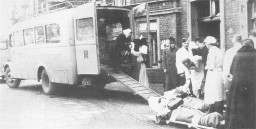
Nazi district leader of Franconia Julius Streicher (right), propaganda minister Joseph Goebbels (second from right), and other Nazi officials attend the opening of the exhibition Der ewige Jude (The Eternal Jew). Munich, Germany, November 8, 1937.
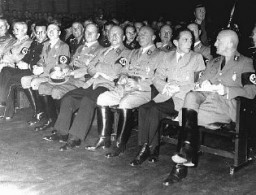
Nazi official Julius Streicher, founder of the antisemitic journal Der Stuermer (The Attacker) and organizer of the anti-Jewish boycott. Munich, Germany, ca. 1933.
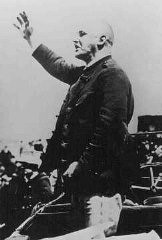
Nazi officials and Catholic bishops listen to a speech by Wilhelm Frick, Reich Minister of the Interior, at an official ceremony in the Saarbrucken city hall marking the reincorporation of the Saarland into the German Reich. March 1, 1935.Among those pictured is Joseph Goebbels (seated at the far right), Franz Rudolf Bornewasser (Bishop of Trier) and Ludwig Sebastian (Bishop of Speyer).
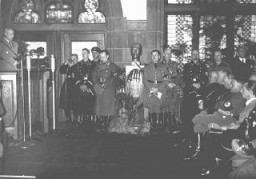
Members of the Storm Troopers (SA) march through the Brandenburg gate. Berlin, Germany, April 8, 1933.
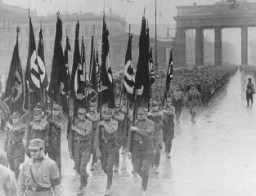
Nazi flags wave above the stadium for the Nazi Party rally grounds in Nuremberg. Architects like Albert Speer constructed monumental edifices in a sterile classical form meant to convey the “enduring grandeur” of the National Socialist movement. Photograph taken in Nuremberg, Germany, between 1934 and 1936.
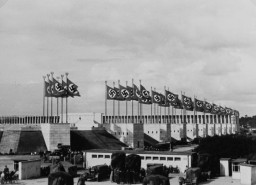
Nazi physician Carl Clauberg, who performed medical experiments on prisoners in Block 10 of the Auschwitz camp. Place and date uncertain.
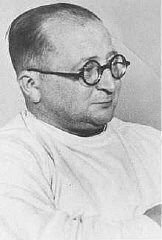
Nazi physician Carl Clauberg (at left), who performed medical experiments on prisoners in Block 10 of the Auschwitz camp. Poland, between 1941 and 1944.
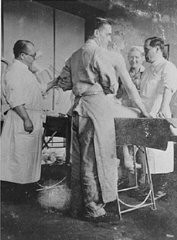
Nazi physician Karl Brandt, director of the Euthanasia Program. August 27, 1942.
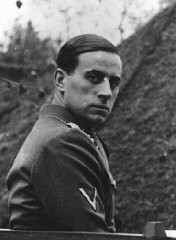
Nazi policy encouraged racially "acceptable" couples to have as many children as possible. Because of the number of children in this Nazi Party official's family, the mother earned the "Mother's Cross." Germany, date uncertain.
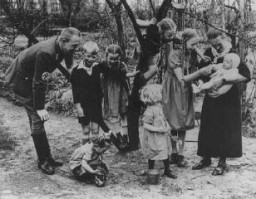
Nazi-produced propaganda slide entitled "Leading Figures of the System." The image was presented during a lecture called "Jewry, Its Blood-based Essence in Past and Future," Part I in a series on Jewry, Freemasonry, and Bolshevism. Germany, circa 1936.The slide features the portraits of six prominent Jewish political and cultural figures in Weimar Germany. Georg Bernhard, Rudolf Hilferding, and Walther Rathenau were among the authors whose works were targeted during the 1933 Nazi book burnings.
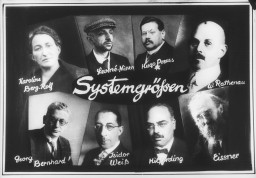
Modern techniques of propaganda—including strong images and simple messages—helped propel Adolf Hitler from being a little known extremist to a leading candidate in the 1932 German presidential elections. Election poster, 1932; photograph by Heinrich Hoffmann.
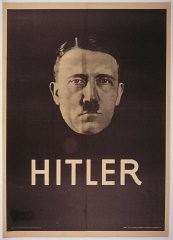
Nazi propaganda poster for 1932 elections, declaring Adolf Hitler to be the last hope of impoverished Germans.

The cover of a Nazi publication on race, Neues Volk (New People), portrays motherhood with this ideal image of an "Aryan" mother and child. Germany, September 1937.

Nazi propaganda postcard showing a crowd of saluting Germans superimposed on an enlarged image of Adolf Hitler with a member of the SA (Sturmabteilung, often called Stromtroopers) who holds a swastika flag. Created in Munich, Germany, ca. 1932.
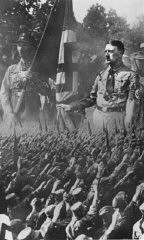
Nazi propaganda poster warning Germans about the dangers of east European "subhumans." Germany, date uncertain.
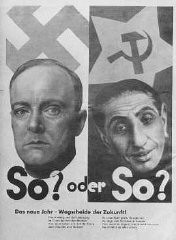
This image shows a 1935 poster by the antisemitic Der Stürmer (Attacker) newspaper. The poster justifies prohibiting “interracial” relationships between Jews and non-Jews under the Nuremberg Race Laws.Many Germans reported suspicions of the “crime” of interracial relationships to the police. The police needed the public to be their “eyes and ears” in this and other matters. Informers were variously motivated by political beliefs, personal prejudices, the desire to settle petty quarrels, or…
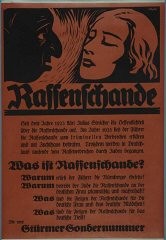
Slide to indoctrinate youth taken from a Nazi propaganda filmstrip. Promoting "euthanasia," it was prepared for the Hitler Youth. The caption says: "Mentally ill Negro (English) 16 years in an institution costing 35,000 RM [Reichsmarks]." Place and date uncertain.
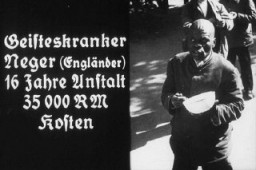
Exhibition of Nazi publications—carefully purged of antisemitic titles—on display during the Berlin Olympics. The poster shows countries in which Hitler's Mein Kampf had been translated into the native language. Berlin, Germany, August 1936.
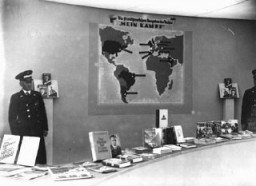
We would like to thank Crown Family Philanthropies, Abe and Ida Cooper Foundation, the Claims Conference, EVZ, and BMF for supporting the ongoing work to create content and resources for the Holocaust Encyclopedia. View the list of donor acknowledgement.